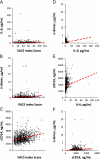Does an index composed of clinical data reflect effects of inflammation, coagulation, and monocyte activation on mortality among those aging with HIV?
- PMID: 22337823
- PMCID: PMC3297653
- DOI: 10.1093/cid/cir989
Does an index composed of clinical data reflect effects of inflammation, coagulation, and monocyte activation on mortality among those aging with HIV?
Abstract
Background: When added to age, CD4 count and human immunodeficiency virus type 1 (HIV-1) RNA alone (Restricted Index), hemoglobin, FIB-4 Index, hepatitis C virus (HCV), and estimated glomerular filtration rate improve prediction of mortality. Weighted and combined, these 7 routine clinical variables constitute the Veterans Aging Cohort Study (VACS) Index. Because nonroutine biomarkers of inflammation (interleukin 6 [IL-6]), coagulation (D-dimer), and monocyte activation (sCD14) also predict mortality, we test the association of these indices and biomarkers with each other and with mortality.
Methods: Samples from 1302 HIV-infected veterans on antiretroviral therapy were analyzed. Indices were calculated closest to date of collection. We calculated Spearman correlations stratified by HIV-1 RNA and HCV status and measured association with mortality using C statistics and net reclassification improvement (NRI).
Results: Of 1302 subjects, 915 had HIV-1 RNA <500 copies/mL and 154 died. The VACS Index was more correlated with IL-6, D-dimer, and sCD14 than the Restricted Index (P < .001). It was also more predictive of mortality (C statistic, 0.76; 95% confidence interval [CI], .72-.80) than any biomarker (C statistic, 0.66-0.70) or the Restricted Index (C statistic, 0.71; 95% CI, .67-.75). Compared to the Restricted Index alone, NRI resulted from incremental addition of VACS Index components (10%), D-dimer (7%), and sCD14 (4%), but not from IL-6 (0%).
Conclusions: Among HIV-infected individuals, independent of CD4, HIV-1 RNA, and age, hemoglobin and markers of liver and renal injury are associated with inflammation. Addition of D-dimer and sCD14, but not IL-6, improves the predictive accuracy of the VACS Index for mortality.
Figures



Comment in
-
Role of the veterans aging cohort study index in assessing total atherosclerotic burden.Clin Infect Dis. 2012 Sep;55(5):750-1; author reply 751-2. doi: 10.1093/cid/cis537. Epub 2012 Jun 5. Clin Infect Dis. 2012. PMID: 22670040 Free PMC article. No abstract available.
References
-
- Justice AC. HIV and aging: time for a new paradigm. Curr HIV/AIDS Rep. 2010;7:69–76. - PubMed
-
- Brown ST, Kyriakides K, kirkwood K, et al. The VACS risk index responds to treatment interventions and is highly correlated with and predictive of mortality events in the OPTIMA study. Int AIDS Conf. 2010
-
- Tate JP, Justice AC, Hughes MD, et al. Program and abstracts of the 15th International Workshop on HIV Observational Databases (Prague, Czech Republic) Bordeaux, France: IWHOD; 2011. Performance of the refined VACS risk index during the first 12 months of antiretroviral therapy among US and European subjects.
Publication types
MeSH terms
Substances
Grants and funding
- T32 ES07069/ES/NIEHS NIH HHS/United States
- K23 AG024896/AG/NIA NIH HHS/United States
- U24 AA022001/AA/NIAAA NIH HHS/United States
- R01-HL095136/HL/NHLBI NIH HHS/United States
- R01-AG029154/AG/NIA NIH HHS/United States
- R01 HL090342/HL/NHLBI NIH HHS/United States
- R01 AG029154/AG/NIA NIH HHS/United States
- U10-AA13566/AA/NIAAA NIH HHS/United States
- R01-HL090342/HL/NHLBI NIH HHS/United States
- U10 AA013566/AA/NIAAA NIH HHS/United States
- T32 ES007069/ES/NIEHS NIH HHS/United States
- U01 AA020790/AA/NIAAA NIH HHS/United States
- P30 AI027763/AI/NIAID NIH HHS/United States
- RCI-HL100347/HL/NHLBI NIH HHS/United States
- RC1 HL100347/HL/NHLBI NIH HHS/United States
- R01 HL095136/HL/NHLBI NIH HHS/United States
LinkOut - more resources
Full Text Sources
Medical
Research Materials

